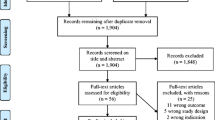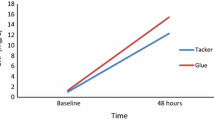Abstract
Background: The purpose of a prospective randomized study was to compare the surgical trauma in patients undergoing laparoscopic or open hernia repair.
Methods: Postoperative pain, analgesic consumption, and metabolic response to surgery were assessed in 30 patients undergoing laparoscopic (group 1; n=15) or open (group II; n=15; Shouldice repair) unilateral inguinal hernia repair. Both groups were comparable with respect to age, sex, and type and size of inguinal hernia.
Results: Postoperative visual analogue scales (VAS) for pain were reduced on mobilization for patients of group I with a significant difference (P=0.02) on the operative day, whereas pain scores at rest and analgesic requirements were similar for both groups. No differences between groups I and II were found in postoperative levels of interleukin-1, interleukin-6, tumor necrosis factor alpha, Creactive protein, fibrinogen, transferrin, alpha-1-antitrypsin, and white blood cells. Postoperative polymorphonuclear (PMN) elastase concentrations remained within normal range in group II but showed a significant increase in patients operated laparoscopically for postoperative days 1 and 2.
Conclusions: No major surgical trauma was found after herniorraphy compared to open hernia repair.
Similar content being viewed by others
References
Arregui ME, Navarrete J, Davis CJ, Castro D, Nagan RF (1993) Laparoscopic inguinal herniorrhaphy: techniques and controversies. Surg Clin North Am 73: 513–527
Colley CM, Fleck A, Goode AW, Muller BR, Myers MA (1983) Early time course of the acute phase protein response in man. J Clin Pathol 36: 203–207
Corbitt JD (1993) Laparoscopic herniorrhaphy: a preperitoneal tension-free approach. Surg Endosc 7: 550–555
Cruickshank AM, Fraser WD, Burns HJG, Van Damme J, Shenkin A (1990) Response of serum interleukin-6 in patients undergoing elective surgery of varying severity. Clin Sci 79:161–165
Di Padova F, Pozzi C, Tondre MJ, Tritapepe R (1991) Selective and early increase of IL-1 inhibitors, IL-6 and cortisol after elective surgery. Clin Exp Immunol 85: 137–142
Gilbert AI (1992) Sutureless repair of inguinal hernia. Am J Surg 163: 331–335
Glassow F (1984) Inguinal hernia repair using local anaesthesia. Ann R Coll Surg Engl 66: 382–387
Huskisson EC (1974) Measurement of pain. Lancet 2: 1127–1131
Joris J, Cigarini I, Legrand M, Jacquet N, De Groote D, Tranchimont P, Lamy M (1992) Metabolic and respiratory changes after cholecystectomy performed via laparotomy or laparoscopy. Br J Anaesth 69: 341–345
Kavic MS (1993) Laparoscopic hernia repair. Surg Endosc 7: 163–167
Lichtenstein IL, Shulman AG, Amid PK, Montllor MM (1989) The tension-free hernioplasty. Am J Surg 157: 188–193
McMahon AJ, Dwyer PJO, Cruickshank AM, McMillan DC, O'Rielly DSJ, Lowe GDO, Rumley A, Logan RW, Baxter JN (1993) Comparison of metabolic responses to laparoscopic and minilaparotomy cholecystectomy. Br J Surg 80: 1255–1258
Milkins RC, Lansdown MJR, Wedgwood KR, Brough WA, Royston CMS. (1993) Laparoscopic hernia repair: a prospective study of 409 cases. Minim Inv Ther 2: 237–242
Nyhus LM, Pollak R, Bombeck CT, Donahue PE (1988) The preperitoneal approach and prosthetic buttress repair for recurrent hernia: the evolution of a technique. Ann Surg 208: 733–737
Shakespeare PG, Ball AJ, Spurr ED (1989) Serum protein changes after abdominal surgery. Ann Clin Biochem 26: 49–57
Stahl WA (1987) Acute phase protein response to tissue injury. Crit Care Med 15: 545–550
Stoppa RE, Warlaumont CR (1989) The preperitoneal approach and prosthetic repair of groin hernia. In: Nyhus LM, Condon RE (eds) Hernia. JB Lippincott, Philadelphia, pp 199–225
Wantz GE (1984) Complications of inguinal hernial repair. Surg Clin North Am 64: 287–298
Welsh DRJ, Alexander MAJ (1993) The Shouldice repair. Surg Clin North Am 73: 451–469
Author information
Authors and Affiliations
Rights and permissions
About this article
Cite this article
Schrenk, P., Bettelheim, P., Woisetschläger, R. et al. Metabolic responses after laparoscopic or open hernia repair. Surg Endosc 10, 628–632 (1996). https://doi.org/10.1007/BF00188515
Received:
Accepted:
Issue Date:
DOI: https://doi.org/10.1007/BF00188515




